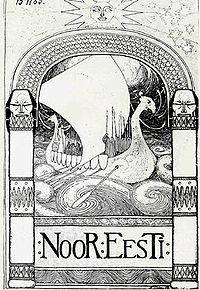
Young Estonia
Encyclopedia

Gustav Suits
Gustav Suits is considered one of the greatest Estonian poets. He was also an early leader of the literary movement group Noor-Eesti .- Childhood and Education :...
and short story writer Friedebert Tuglas
Friedebert Tuglas
Friedebert Tuglas was an Estonian writer and critic who introduced Impressionism and Symbolism to Estonian literature. Persecuted under the czar, he became an acknowledged representative of Estonian literature in the Soviet era.-Biography:The son of a carpenter, Tuglas studied at the Hugo Treffner...
. Other members of the group included Villem Grünthal-Ridala
Villem Grünthal-Ridala
Villem Grünthal-Ridala, born Grünthal-Wilhelm was an Estonian poet, translator, linguist and folklorist.-Life:...
and Johannes Aavik
Johannes Aavik
Johannes Aavik was an Estonian philologist and Fennophile who played a significant role in the modernization and development of the Estonian language.-Education and career:...
. Gustav Suits articulated the ideology of the group thus:
"What buoys up and exalts humanity is education. Our slogan is: More culture! More European culture! Let us remain Estonians, but let us become Europeans too. We want to discover the ideas and forms towards which we are impelled by our national spirit, character, and needs on the one hand, and by European culture on the other."
The group's aesthetic programme followed the trends of Finnish, French, German, Scandinavian and Italian literature of the time, comprising elements of Impressionism
Impressionism
Impressionism was a 19th-century art movement that originated with a group of Paris-based artists whose independent exhibitions brought them to prominence during the 1870s and 1880s...
, Symbolism
Symbolism (arts)
Symbolism was a late nineteenth-century art movement of French, Russian and Belgian origin in poetry and other arts. In literature, the style had its beginnings with the publication Les Fleurs du mal by Charles Baudelaire...
and Expressionism
Expressionism
Expressionism was a modernist movement, initially in poetry and painting, originating in Germany at the beginning of the 20th century. Its typical trait is to present the world solely from a subjective perspective, distorting it radically for emotional effect in order to evoke moods or ideas...
. The 1917 Russian Revolution
October Revolution
The October Revolution , also known as the Great October Socialist Revolution , Red October, the October Uprising or the Bolshevik Revolution, was a political revolution and a part of the Russian Revolution of 1917...
dispersed members of the movement, with some fleeing into exile. The group also functioned as a publishing house and published five Young Estonia anthologies between 1905 and 1915.

